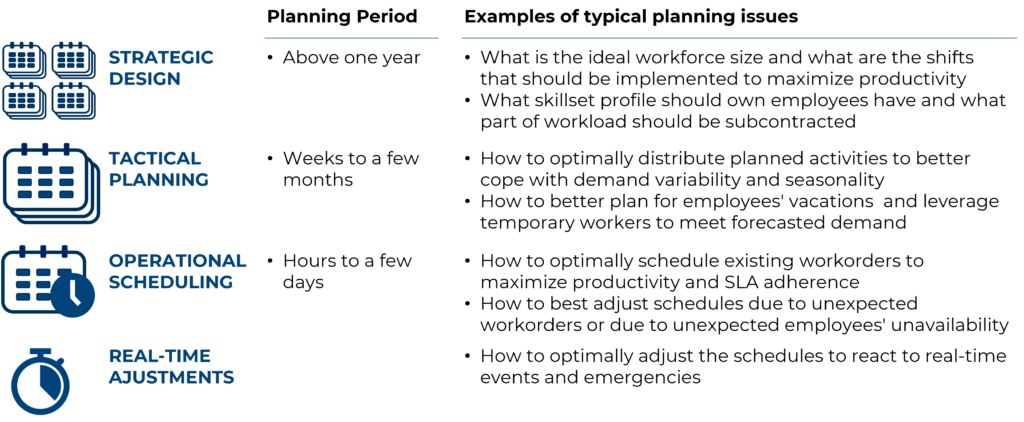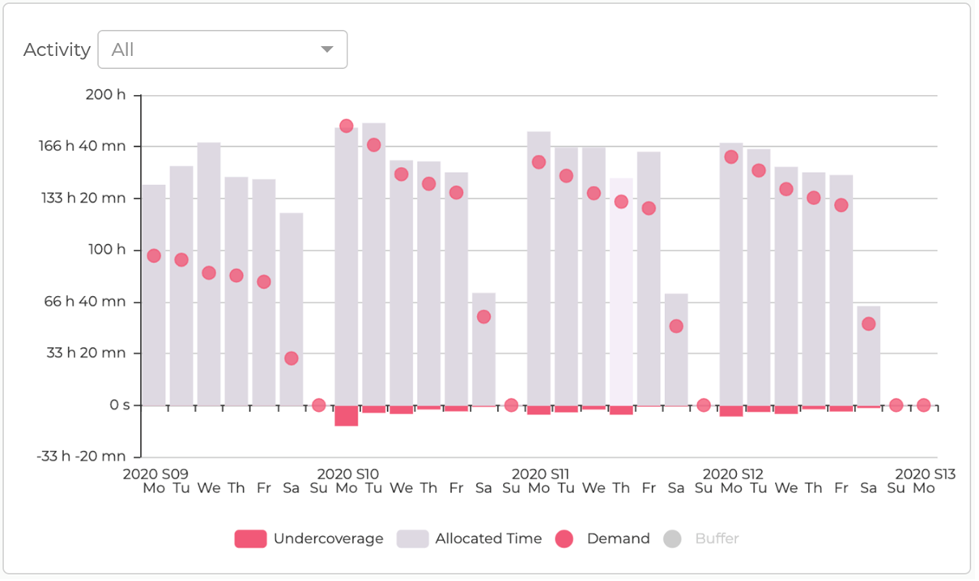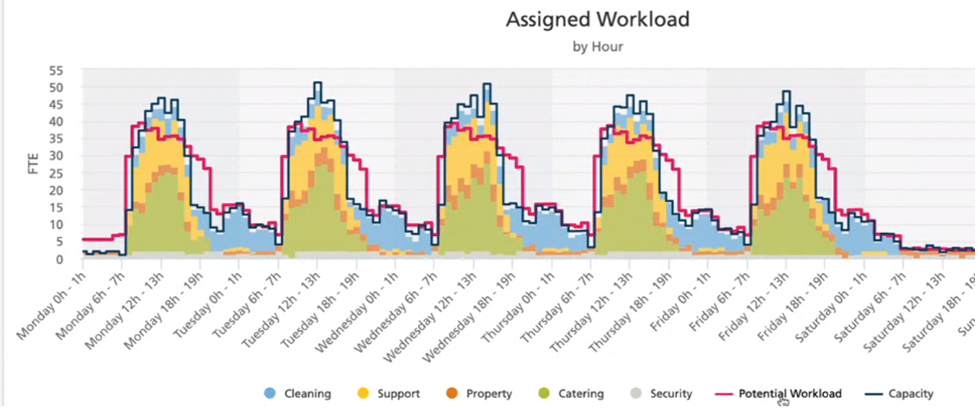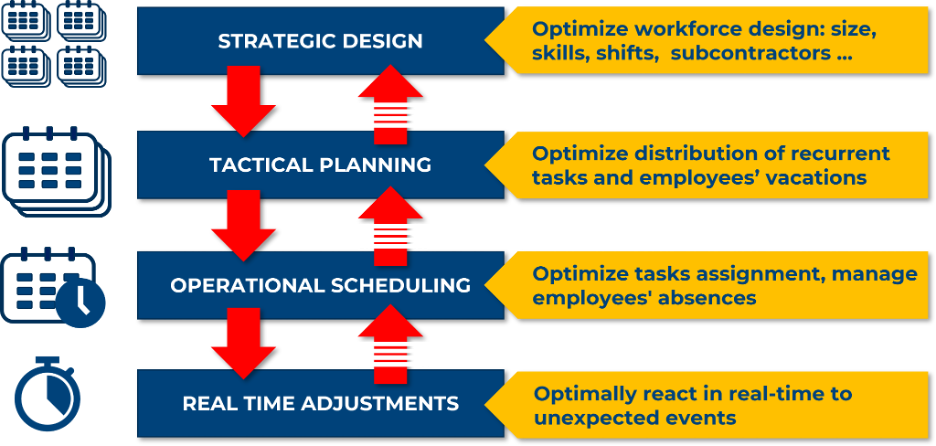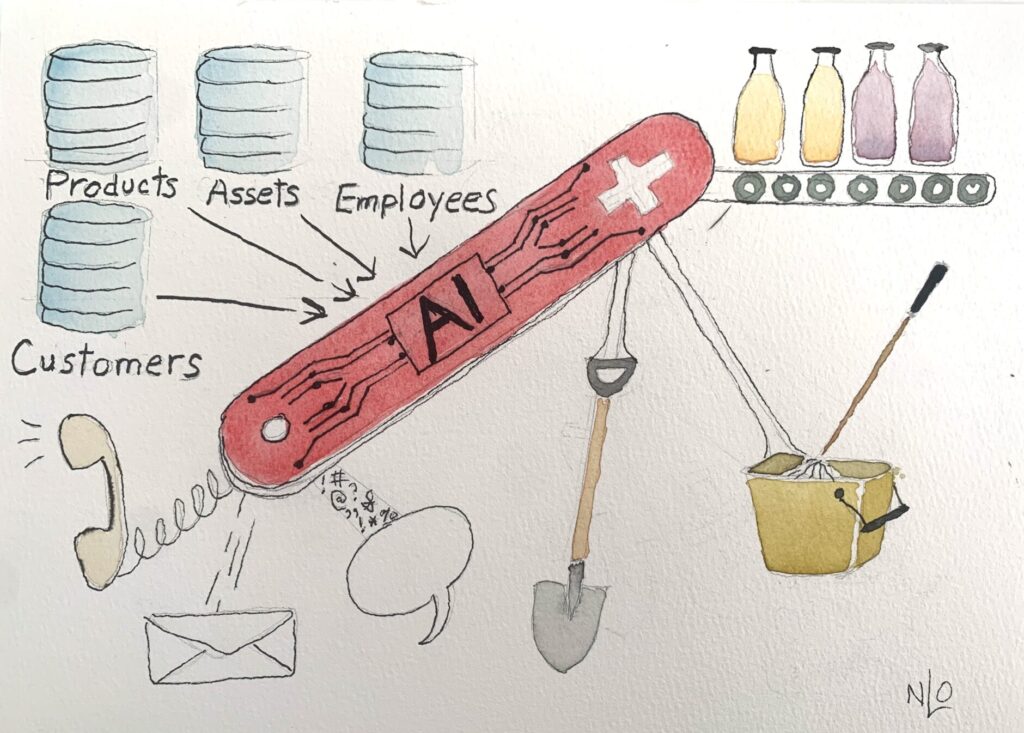Blog
Part 5: Tactical Planning – The Complete Guide To Workforce Optimization
In our first 3 blog posts in this series, we learned about the foundational data work required before one can utilize AI software systems to optimize workforce planning and scheduling, specifically:
- 1. Create a
catalog of employee skills and work task types
so that we have a common language with which to talk about workforce capacity and work demand
- 2.
Benchmark activity performance
rates for the various task types so that we can determine how much workforce capacity is needed to fulfill a given amount of work.
- 3. Handle uncertainty with forecasting and capacity planning as inputs for our workforce optimization activities.
In our previous post, Part 4 Schedule Optimization , we learned how to use all of this data to perform our first optimization step: Dynamic Scheduling. We talked about many of the important inputs to dynamic scheduling systems, including a demand forecast. Another very important input is a good tactical plan.
What is Tactical Workforce Planning?
Most organizations must meet a variety of obligations that are set on an annual basis. The specific arrangement or distribution of these activities throughout the year is what Tactical Planning focuses on. It is therefore considered to be a mid-term planning activity, in which decisions have an impact a few weeks to a few months out.
Tactical planning decisions are usually of two types:
- Distribution of planning activities to better cope with demand variability & seasonality
- Planning employee vacations, training and contractor utilization.
Planned Activity Distribution
Business uncertainties make it hard to precisely schedule certain activities a full year out, including those that are planned or recurring. For instance:
- A maintenance contract might require that equipment be serviced based on utilization metrics (e.g. every 4000 hours of oven utilization or every 2000 elevator door opens). Actual utilization will vary throughout the year so the service plan will need to be adjusted accordingly.
- Medical sales representatives may be required to visit doctors at a certain frequency, but cancellations are very common. It is therefore necessary to replan throughout the year to ensure that visit frequency targets are met.
- Equipment, materials, parts and/or supplies needed by construction crews may have availability limitations or could be disrupted for many reasons, e.g. shipping vessels or expensive excavation machinery may only be available to offshore or onshore construction workers at certain times of the year. Weather or other events may impact their availability, so rest-of-year plans need to be adjusted accordingly.
Tactical planning systems enable organizations to manage these uncertainties by regularly adjusting the plan over the impacted time horizon based on the latest ground truth (e.g. rolling 12-month plan for equipment maintenance planning or a 1-mo plan for sales visit planning).
Below is a sample chart showing a capacity plan 1 month out in terms of the level of demand satisfaction. Most of the time the total allocated workforce capacity (light bars) exceeds demand, which means there is adequate coverage for the first week. For the remaining 3 weeks in the month, the dark pink bars at the bottom show that, although there appears to be adequate total coverage, some tasks are actually undercovered because there are not enough workers with the right skills to meet the demand.
Figure 1: One-Month Tactical Workforce Capacity Plan
Figure 2: Tactical Workforce Demand – Gantt View
Below is a more complex example of a tactical capacity plan, first before, then after optimization. The different colors represent different types of demand and therefore different employee roles. Notice the over-staffing in the first chart, depicted as white-space below the dark blue line. In the second chart, overstaffing has been reduced through optimization.
Figure 3: Monthly Capacity Plan Before & After Optimization
Planning Time Off, Training & Contractor Utilization
Reacting to the Unexpected with Tactical Planning
Just as certain planned and recurring customer and internal business activities can’t be effectively scheduled a full year in advance, neither can employee time off, training sessions, or contractor utilization because it’s hard to predict, for instance:
- When employees will request short-term time off
- When employees will require longer-term medical and parental leave
- When employees may resign or strike
- Major client contract acquisitions or terminations
- Certain compliance or training requirements.
Greater planning agility throughout the year helps organizations operate more efficiently while also satisfying employees who appreciate greater flexibility in their schedules.
Since tactical planning is all about dealing with real-world uncertainties, how exactly are unexpected events handled? They can be handled in multiple ways, depending on the extent of the disruption.
If the event causes a major operational disruption, it may be necessary to replan over the full-time horizon since the effects could be felt over much or all of the month/year/etc period. In some cases, it may also be worthwhile to relax some prior constraints because the new plan may be impossible to calculate under the prior constraints (or it could be a lot more complicated to compute). For instance, one could allow more overtime than usual or greater utilization of contractors.
If the disruption is minor, it may be possible to just locally repair the plan, perhaps by rescheduling a job and/or adjusting one person’s usual route.
For a moderately significant disruption that falls somewhere in between the prior examples, one option could be to “freeze” certain parts of the plan and allow the system to replan everything else.
Figure 4: Manual Plan Adjustment & Task Reassignment
Anticipating Disruption with Preventative Measures
Several preventative measures can be taken in designing tactical plans so that unexpected events are less disruptive. For example:
- Workload balancing & smoothing – Tactical planning optimization software can be set up to smooth the workload over a time horizon. This allows more flexibility to tackle unexpected events on a given day. (See Figure below)
- Buffers – Deliberately adding some daily/weekly schedule buffer is another way to allow for uncertainty. That means not creating schedules that are too tightly packed.
- Reducing Scheduling Granularity – It’s tempting to want to make the most detailed schedule possible, but some organizations take the opposite approach, for instance by assigning a set of activities over a full day, week or month and allowing the employees and their managers to be empowered to handle the scheduling details. It can also improve employee satisfaction because field staff may have preferences that the software system doesn’t take into account.
Figure 5: Workload Smoothing
Tactical Planning and Scheduling Go Hand-in-Hand
As mentioned earlier, tactical planning systems need to take into account the current reality on the ground.
Let’s say a perfectly optimized tactical plan is created and it assigns 100 jobs to the field team. Then, when the operational scheduling system tries to optimize the routes, it may be discovered that 10% of the jobs can’t be fulfilled, due perhaps to unusual traffic, equipment malfunction, employee illness or parts shortages.
To address this problem, the tactical planning and operational scheduling systems iterate back and forth, as shown below:
Scenario Testing for Resilience & Risk Management
Risk management is critical for any business and tactical planning systems can be used to help organizations prepare their workforces for certain anticipated but unlikely situations. This is best achieved through scenario analysis within tactical planning systems.
Some of the questions that can be answered through scenario analysis include:
- Demand Variability – How well could I accommodate unusually high or lower demand of a certain type? How much buffer is necessary to ensure a good service level? How would my costs be impacted? Are temporary workers needed?
- Step-changes in the demand – What would be the impact of taking on certain additional work, such as expanding the scope of existing contracts or winning new ones? How could the workforce be restructured in case of loss of a contract?
- Shift Design – What would be the impact of modifying shift structures? Which alternate shifts should be assigned to employees in the next few months?
- Skill Design – Where do we have skills shortages? Which employees could be candidates for skills training? When is a good time to plan full-day training and how large should the groups be?
Figure 6: Distribution of employee training (upskilling)
- Team Design – Which main activities should be assigned to a team? Are any teams overstaffed or understaffed? What impact could task-team redistribution have?
- Leave Design – How should time off be distributed to minimize negative business impact?
Figure 7: Employee unavailability
Example: Earthquake Disrupts Electrical Grid Provider’s Operations
Let’s imagine the case of an electrical energy provider that is planning and scheduling their field service team. An earthquake hits and causes damage to a portion of their grid infrastructure. A repair crew is quickly assembled and dispatched, thanks to the operational scheduling system. This crew might now include more contractors than had been previously planned. The total cost impact will be immediately known, thanks to KPI tracking in the schedule optimization system.
The job is expected to take a few weeks. This means that some previously scheduled maintenance work would be delayed or re-assigned, depending on the specific service level agreements (SLAs).
If this company has integrated a tactical planning system with their scheduling system, the new schedule and capacity plan would be sent to the tactical planning system, which would then “repair” the tactical plan for the next rolling 12-month period. After that, the new plan would be fed back into the scheduling system as the baseline for creating future weeks’ schedules.
Given the latest work demand, the tactical planning system might suggest some high-level adjustments to future plans. Those changes could include postponing this team’s maintenance work or moving some shifts. It might also pull forward some maintenance work that was previously scheduled a month or two out, but which can be efficiently completed in parallel with the repair work. The system could suggest these changes because it knows that the work is close by, the necessary equipment is available and the technicians have the needed skills to do this work.
Conclusion
Uncertainty is a fact of life, even more so in the post-pandemic era. Tactical planning optimization is one of the most overlooked opportunities for operational efficiency improvement. We at DecisionBrain have tackled this problem for various industries. Reach out to us if you’d like to discuss your particular planning and scheduling challenges.
Other articles in The Complete Guide to Workforce Optimization:
Introduction to our Series
Part 1 Cataloging Employee Skills and Work Activities
Part 2 Benchmarking Performance Metrics
Part 3: Handling Uncertainty with Forecasting and Capacity Planning
Part 4: Operational Scheduling
Part 6 Strategic Planning

